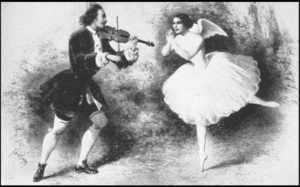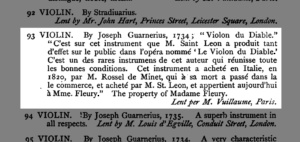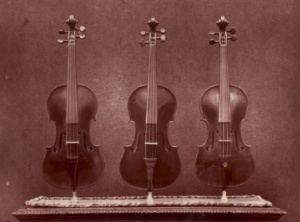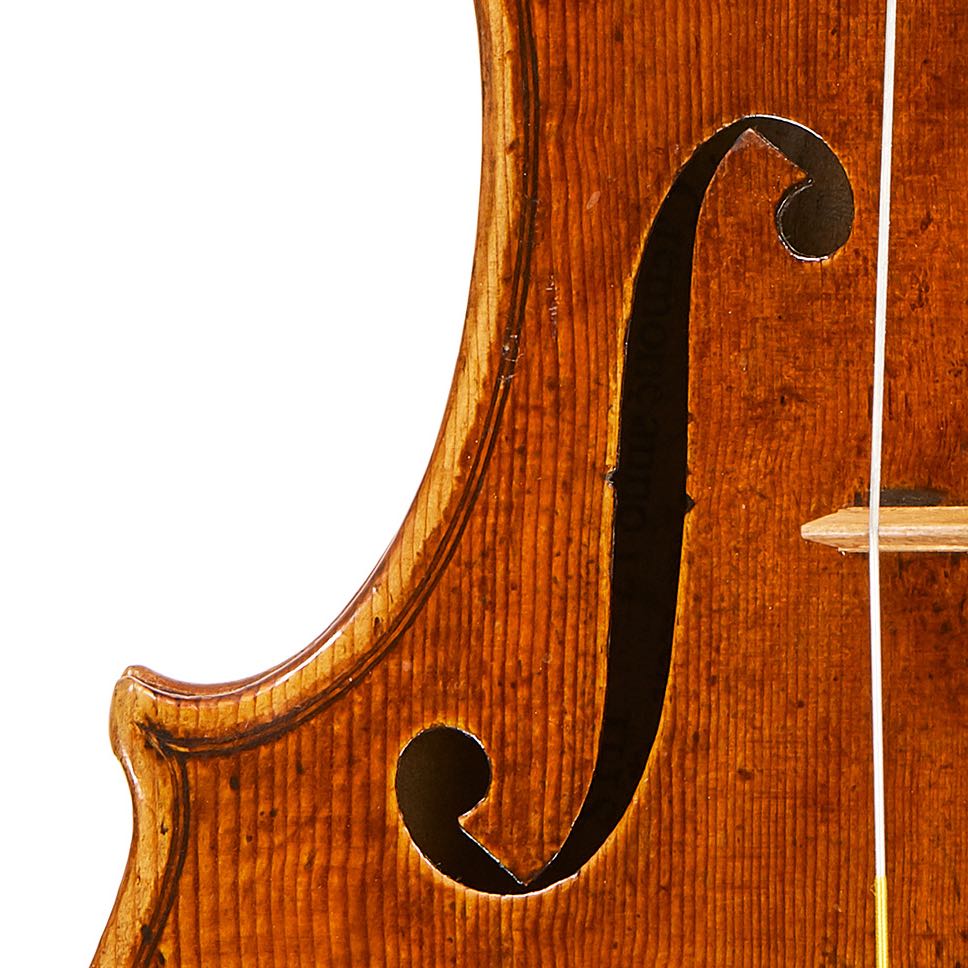Fritz Kreisler fell in love with it; Alfred Hill called it one of the finest Guarneris in existence; J. B. Vuillaume put it on par with the ‘Messiah’ and the ‘Pucelle’. Earlier this year, Tarisio had the privilege of selling the exquisite ‘Violon du Diable’ by Private Sale to a discerning collector and music advocate.
One of the finest Guarneris in existence: the 1734 ‘Violon du Diable’
Recently sold by Private Sale, this 1734 ‘del Gesù’ has enthralled players, collectors and experts for centuries.
By Jason Price November 30, 2022This famous Guarneri takes its name from a ballet titled Le Violon du Diable written by Cesare Pugni in 1849. The ballet tells of a young violinist who falls madly in love with a woman who does not love him in return. The violinist asks an evil doctor to cast a spell on his violin so that its sound will make his beloved fall in love and in exchange, the violinist gives up his soul to the devil. The ballet premiered on January 19, 1849, at the Paris Opera. The lead role was played by the French violinist, dancer and choreographer, Arthur Saint-Léon and the violin he played on was the 1734 Guarneri which came to be known as the ‘Violon du Diable’.

Arthur Saint-Léon and his wife Fanny Cerrito in a contemporary illustration of the ballet Le Violon du Diable by the French illustrator and lithographer Ange-Louis Janet.
The ballet was a success, garnering Saint-Léon praise as both a dancer and violinist. The Faustian pact between musician and devil was a subject familiar to classical music audiences. The virtuosos Giuseppe Tartini and Nicolò Pagannini were both rumored to have made such a deal with the devil and the drama played well with popular imaginations. The poet and critic Théophile Gautier wrote in La Presse three days after the premier:
One of the great curiosities of this ballet is to hear Saint-Léon play the violin not like a dancing master, but like a consummate virtuoso. In his hands there is nothing implausible about a violin with magical powers … Le Violon du Diable has the appeal of both a concert and a ballet, the music and the choreography are equal, Saint-Léon’s fingers are just as nimble as his legs.[1]
Between 1859 and 1869 Saint-Léon served as the Maître de Ballet of the Imperial Russian Ballet, and we can assume that the ‘Violon du Diable’ traveled there with him. Indeed, in 1869 the musical historian and biographer Jules Gallay lists Saint-Léon in St. Petersburg as the owner of the Guarneri.[2]
Vuillaume was on the loan committee to the exhibition and the three instruments he procured were arguably the most important on display, each a masterpiece in its own right
Saint-Léon died in 1870, and two years later the ‘Violon du Diable’ was exhibited in London at the South Kensington Exhibition of 1872. The South Kensington Exhibition was a landmark event in the history of violin collecting and marked the first time that so much popular attention had been paid to antique musical instruments.

J. B. Vuillaume’s descriptive text of the ‘Violon du Diable’ in the catalog to the 1872 South Kensington Exhibition. The catalog hints at a previous owner, a Monsieur Rossel de Minet who had acquired it in Italy in 1820.
The French dealer Jean Baptiste Vuillaume was on the loan committee to the exhibition and the three instruments he procured were arguably the most important on display, each a masterpiece in its own right: the 1716 ‘Messiah’ Stradivari, the 1709 ‘Pucelle’ Stradivari and the 1734 ‘Violon du Diable’ Guarneri.[3] The romantic names given to these violins – the ‘Messiah’, the ‘Devil’ and the ‘Maiden’ – reveal the fairy-tale myth-making which was well underway in the fiddle business by the 19th century. These three violins were photographed together during the exhibition, and this image is one of the earliest recorded photographs of important instruments.

A photograph of the three instruments at the time of the 1872 South Kensington Exhibition shows the ‘Messiah’ flanked by the ‘Pucelle’ and the ‘Violon du Diable’. Image used with permission from Benjamin Hebbert.
In 1875 Vuillaume sold the ‘Violon du Diable’ for 6,000 francs to Eugène Fau, a banker, manufacturer and amateur violinst in the wool processing town of Castres, 44 miles from Toulouse in South Western France. Fau was a long-standing and important client of Vuillaume and had previously purchased from him the 1716 ‘Fau, Hass’ Stradivari and the c. 1707 ‘Castelbarco’ Stradivari cello. In 1865 Vuillaume had even offered Fau the ‘Messiah’ Stradivari at a price of FF10,000 but the latter declined.
“[Kreisler] has fallen in love with our Guarnerius, the one known as the ‘Diable'”
In 1910 the ‘Violon du Diable’ was purchased by W. E. Hill & Sons from a descendent of Dr. Fau for 35,000 francs. On June 25th of that year Arthur Hill noted that his brother Alfred had returned to London from France “bringing back with him one of the finest violins by Joseph Guarnerius in existence.”[4] Four months later, the Hills showed the ‘Violon du Diable’ to the great Viennese violinist Fritz Kreisler and noted, “[Kreisler] has fallen in love with our Guarnerius, the one known as the ‘Diable’ which Alfred bought [from] M. Fau a short time ago.”[5]
But Kreisler wasn’t quick enough and in late 1910, the ‘Violon du Diable’ was acquired by the Hills’ faithful client, the collector, Robert E. Brandt for £2,300. Three years later the violin traded hands again, this time landing it in the collection of Richard Bennett who acquired the violin for £3,000 on May 31, 1913. Bennett’s collection of instruments was arguably the finest ever assembled. The same year that Bennett bought the ‘Diable’ he also acquired the 1716 ‘Messiah’ Stradivari and the c. 1719 ‘MacDonald’ and 1696 ‘Spanish Court’ violas. Bennett’s collection also included the 1715 ‘Baron Knoop’, the 1721 ‘Lady Blunt’, the 1714 ‘Dolphin’, the 1690 ‘Medici, Tuscan’, the 1715 ‘Alard’ and numerous other masterpieces.
When Bennett sold off his collection in the mid-1920s, the ‘Violon du Diable’ was repurchased by the Hills. In their landmark 1931 publication The Violin Makers of the Guarneri Family the Hills included the ‘Diable’ on their list of the nine most important Guarneri violins in existence. The Hills also speculated that the ‘Diable’ could be the 1734 ‘del Gesù’ that was played on by the Italian virtuoso Gaetano Pugnani.[6]

The Hills kept the ‘Diable’ in their collection for nearly 50 years and then in 1972, a year after the ‘Lady Blunt’ had made history selling for £84,500 at Sotheby’s, they sold the ‘Violon du Diable’ to Dr. Rene-Pierre Lacombe of New York for £72,000. At the time they wrote, “This violin is such an outstanding example from all points of view that we have been loath to see it disappear.”[7]
“This violin is such an outstanding example from all points of view that we have been loath to see it disappear.” – W. E. Hill & Sons
The violin was subsequently sold by Jacques Français to an important North American collector and in 1994 it was featured in the landmark exhibition Giuseppe Guarneri ‘del Gesù’ curated by Peter Biddulph at the Metropolitan Museum of Art in New York. The catalog to the exhibition lavished praise on the ‘Diable’, calling it “one of the most stunningly well-preserved and beautiful of Guarneri violins.”[8]
Earlier this year Tarisio sold the ‘Diable’ by Private Sale to a discerning collector and music advocate.
Notes:
- Théophile Gautier, “Opéra: Le Violon du Diable,” La Presse, January 22, 1849.. (“Une des principales curiosités de ce ballet c’est d’entendre Saint-Léon jouer du violon non comme un maître à danser qui agace sa pochette, mais comme un virtuose consommé. Un instrument magique n’a rien d’invraisemblable entre ses mains. Ce double talent ne peut manquer de produire un effet sur les recettes, car Le Violon du Diable à l’attrait d’un concert et d’un ballet, les morceaux et les pas se valent, Saint-Léon a les doigts aussi agiles que les jambes”).
- Gallay, Jules, Les Luthiers Italiens 17th-18th centuries, Paris, 1869, p. 232.
- Engel, Carl, Catalog of the Special Exhibition of Ancient Musical Instruments, MDCCCLXXII, London, 1874.
- W. E. Hill & Sons Business Records, unpublished, June 25, 1910.
- W. E. Hill & Sons Business Records, unpublished, October 9, 1910.
- Hill, William Henry; Hill, Arthur Frederick; Hill, Alfred Ebsworth, The Violin-Makers of the Guarneri Family (1626-1762), W .E. Hill & Sons, London, 1931, p. 113.
- Letter from Desmond Hill to Dr. Lacombe, unpublished, 17 October 1972.
- Biddulph, Peter, The Violin Masterpieces of Guarneri del Gesù, London, 1998.
Browse the Cozio Archive
210,000+ Photographs
36,000+ Instruments & Bows
3,500+ Violin & Bow Makers
11,000+ Historical Owners
57,000+ Auction Results
14,000+ Certificates & Documents
Sign up to our newsletter
